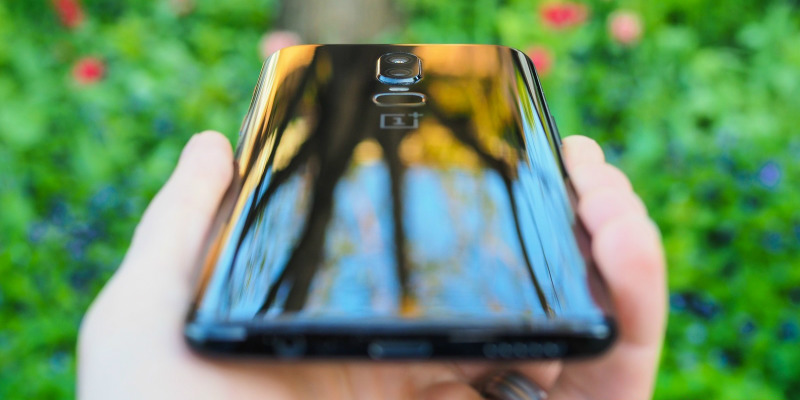MobileVillage (MV) & Appcelerator (APP) bring you a quick read of the week’s biggest mobile apps news & mobile tech news. In this mobile news roundup: Hydrogen One 3D phone 8K camera, OnePlus 6 reviews, HTC U12+ specs, Belkin audio Lightening cable, cheap Microsoft Surface leak, SharePoint spaces, SharePoint app find feature, Android phone security, Twitter limits other apps, Starbucks leads mobile payments in the US, Facebook wireless service, App Store improved app discovery, new Australia tech center, improving AR app security & more.
Cheap Microsoft Surface coming this year?
It’s been several years since Microsoft offered a sub-$500 Surface tablet, but insiders told Bloomberg that the company plans to add a new, $400 Surface to compete with the iPad. The cheap Microsoft Surface will have a 10-inch screen, rounded corners, kickstand and USB C port, a choice of 64GB or 128GB of storage, Intel processor and graphics chips, and option for an LTE cellular SIM card. You’ll also likely see a new cheap Microsoft Surface keyboard cover.
The new cheap Microsoft Surface will weigh up to 20 percent less but also have shorter battery life—the current Surface Pro can last 13.5 hours on one charge. And unlike the low-end Surfaces of several years ago, the new $400 Surface will run Windows 10 Pro, according to the Bloomberg sources. No word on when we’ll see the cheap Microsoft Surface, but a likely time will be early fall, in time for the holiday shopping season. — MV
Hydrogen One 3D phone to boast 8K camera
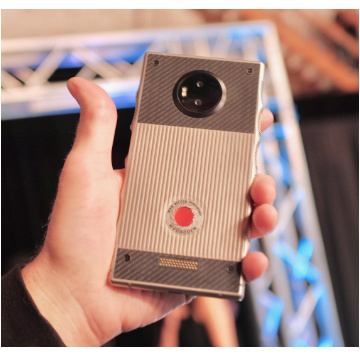 Two startup companies—RED and Lucid—have teamed up to put a 3D, 8K camera into RED’s upcoming Hydrogen One Android phone. This week RED showed off a prototype of the Hydrogen One 3D phone, which has two synced 4K cameras that capture and convert video and images to 8K 4V (.h4v) files. You can view those on the Hydrogen One’s “holographic” 3D display and upload them to Facebook, YouTube and RED’s own content hub.
Two startup companies—RED and Lucid—have teamed up to put a 3D, 8K camera into RED’s upcoming Hydrogen One Android phone. This week RED showed off a prototype of the Hydrogen One 3D phone, which has two synced 4K cameras that capture and convert video and images to 8K 4V (.h4v) files. You can view those on the Hydrogen One’s “holographic” 3D display and upload them to Facebook, YouTube and RED’s own content hub.
Lucid already sells the LucidCam, a camera that can shoot 180-degree 3D VR video and photos. If you can afford both the LucidCam and the Hydrogen One phone when it’s out, you can insert the phone into the LucidCam and view the content on the phone in 3D/4V without 3D glasses or a VR headset.
Other Hydrogen One 3D phone specs that we know so far include a 5.7-inch, QHD screen, Snapdragon 835 chip, 4,500 mAh battery, USB Type-C port and headphone jack. RED hopes to release the Hydrogen One 3D phone later this summer, but the 3D display and 8K camera won’t come cheap: the aluminum Hydrogen One will sell for US $1,195, and the titanium model for $1,595. — MV
OnePlus 6 reviews roundup
The new OnePlus 6 reviews are in, and they’re pretty winning. Engadget calls it “a uniquely gorgeous device with intuitive features, as well as solid battery life and a great camera.” Android Authority gushes: “this phone is amazing—it’s fast, easy to use, and looks as premium as phones almost twice the price.” And Android Central says that though the OnePlus 6 lacks wireless charging and good haptics (vibration feedback), it’s “the best smartphone deal in town.”
But CNET and The Verge are slightly less enthusiastic, with The Verge calling out the “average” camera and scratch-prone body, among other gripes.
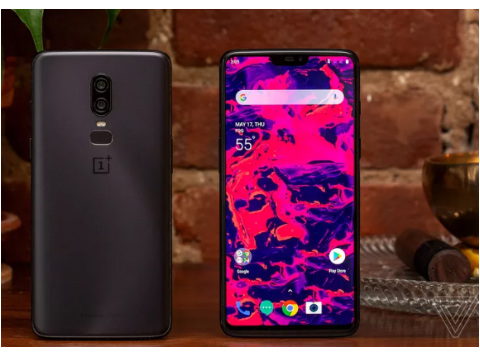 At $529 and up, the OnePlus 6 costs more than last year’s OnePlus models, but it’s still less than other top flagship ones like the Galaxy S9 and iPhone 8 (let alone iPhone X). And it’s been upgraded with lots of new features, most notably a Snapdragon 845 processor, 6 or 8GB of RAM, five-layer-coating glass body with a ceramic look, slightly larger (6.3-inch) display, smaller bezels, a physical volume switch, optional gesture controls, much better cameras (16 and a 20-megapixel Sony sensors with optical image stabilization and super-slow-motion video), and Gigabit LTE support.
At $529 and up, the OnePlus 6 costs more than last year’s OnePlus models, but it’s still less than other top flagship ones like the Galaxy S9 and iPhone 8 (let alone iPhone X). And it’s been upgraded with lots of new features, most notably a Snapdragon 845 processor, 6 or 8GB of RAM, five-layer-coating glass body with a ceramic look, slightly larger (6.3-inch) display, smaller bezels, a physical volume switch, optional gesture controls, much better cameras (16 and a 20-megapixel Sony sensors with optical image stabilization and super-slow-motion video), and Gigabit LTE support.
On the downside, the OnePlus 6 AMOLED display is stuck with a mid-resolution (1080×2280), though that helps with battery life. And the phone lacks some high-end features like microSD expansion, water resistance ratings, and wireless charging, but that keeps the cost down. It also doesn’t work on US CDMA carriers like Verizon, Sprint, and Boost.
You can get the OnePlus 6 now in your choice of a glossy black, a softer, matte black, or matte white with rose-gold frame. The phone starts at $529 for 6GB of RAM and 64GB of storage, but you can also opt for 8GB of RAM with 128GB ($579) or 256GB of storage ($$629). — MV
HTC U12+ specs & price
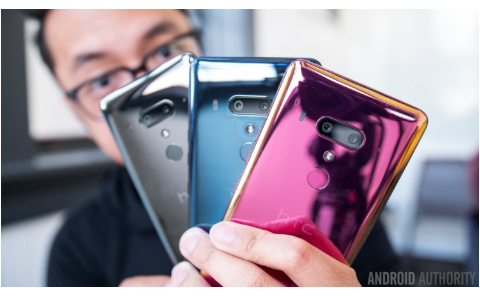 HTC this week revealed its flagship U12+ Android phone, which is another solid high-end phone with minor upgrades from the U11+. As for HTC U12+ specs you’ll see the same “3D liquid glass” design, but you now get a six-inch Quad HD+ (2,880 x 1,440) LCD, Snapdragon 845 chip, 6GB of RAM. Other new HTC U12+ specs include dual rear cameras (12 megapixel wide-angle and 16MP telephoto) for more bokeh effects, 8MP dual front cameras, smart orientation detection, and Edge Sense 2 squeeze control, which makes the phone easier to use one-handed.
HTC this week revealed its flagship U12+ Android phone, which is another solid high-end phone with minor upgrades from the U11+. As for HTC U12+ specs you’ll see the same “3D liquid glass” design, but you now get a six-inch Quad HD+ (2,880 x 1,440) LCD, Snapdragon 845 chip, 6GB of RAM. Other new HTC U12+ specs include dual rear cameras (12 megapixel wide-angle and 16MP telephoto) for more bokeh effects, 8MP dual front cameras, smart orientation detection, and Edge Sense 2 squeeze control, which makes the phone easier to use one-handed.
The U12+ comes with Android Oreo, but you’ll get to upgrade to Android P when that’s available this summer. You can choose from either 64GB or 128GB of storage, which you can expand up to 2TB with microSD cards. You can pre-order one today in black, blue or red for $799 (64GB) or $849 (128GB) from HTC’s site and Amazon. You can see a quick hands-on video and photos over at Engadget and Android Authority. — MV
HTC Exodus blockchain phone in the works
Taiwanese smartphone maker HTC earlier this week spilled some details on its upcoming Exodus phone: it will support decentralized apps, blockchain security, and cryptocurrencies such as Bitcoin and Ethereum through a universal wallet. HTC is reportedly even creating a native blockchain network where Exodus users can trade cryptocurrencies among themselves. No pricing or launch date details for the HTC Exodus phone were revealed. — APP
No Bluetooth? Try the Belkin audio Lightning cable
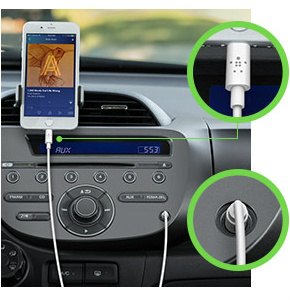 If you listen to your iPhone in a car that has no Bluetooth or other connectivity options, you probably haven’t found a reliable 3.5mm cable with a Lightning connector. The new Belkin audio Lightening cable has you covered, giving you three to six feet of cable to connect your iPhone to the car stereo or home speakers.
If you listen to your iPhone in a car that has no Bluetooth or other connectivity options, you probably haven’t found a reliable 3.5mm cable with a Lightning connector. The new Belkin audio Lightening cable has you covered, giving you three to six feet of cable to connect your iPhone to the car stereo or home speakers.
Belkin is known for quality but not cheap prices, so expect to pay $30 retail for the three-foot audio Lightning cable, or $35 for the six-footer. — MV
Twitter limits third-party apps
Twitter has never limited third-party apps for tweets—until now. Starting this summer, Twitter will restrict current third-party access and replace it with a new system that is much more limited. The change won’t render third-party Twitter clients completely useless, but it will make the apps less effective. New tweets will no longer stream into an app in real-time, requiring users to manually refresh timelines. Secondly and more importantly, they will delay or even outright prevent push notifications in most instances.
The changes are set to go live on August 16, with Twitter providing a pay-to-play feature for developers who want access to the old system. — APP
Microsoft Sharepoint spaces brings AR & VR to any device
 If you’re a Microsoft SharePoint user, you might be excited about the new SharePoint spaces feature, which Microsoft announced this week at its SharePoint conference. SharePoint spaces lets companies and organizations create immersive, mixed reality (AR and VR) experiences that can be viewed on any device–no VR headset needed.
If you’re a Microsoft SharePoint user, you might be excited about the new SharePoint spaces feature, which Microsoft announced this week at its SharePoint conference. SharePoint spaces lets companies and organizations create immersive, mixed reality (AR and VR) experiences that can be viewed on any device–no VR headset needed.
Microsoft says SharePoint spaces can be used for a range of uses, such as immersive recruiting, training, product demos, and education. Content you add in SharePoint spaces can include files or images you already have in SharePoint, as well as non-SharePoint content such as 360-degree videos created with mobile phones.
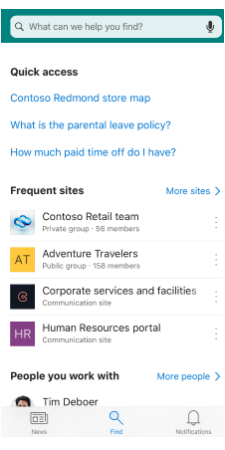 SharePoint spaces will be available later this year in all Office 365commercial plans. For more details, demos, and to apply for a limited preview of SharePoint spaces, see Microsoft’s blog post. — MV
SharePoint spaces will be available later this year in all Office 365commercial plans. For more details, demos, and to apply for a limited preview of SharePoint spaces, see Microsoft’s blog post. — MV
SharePoint app Find feature
In other SharePoint news, the mobile SharePoint app is soon getting a new “Find” search box and tab, where you’ll see links to documents and sites you were recently working on, across your devices.
With the help of artificial intelligence (AI), the new SharePoint app Find feature will also automatically recommend websites, files, news, and people that Microsoft AI thinks are relevant to you, so you might find what you need without having to search. No word yet on when the SharePoint app Find feature (pictured here) will appear, but Microsoft says “soon”. — MV
Android phone security patches to get more frequent
Android devices may soon receive more frequent security patches. Google has announced that it’s making new deals with its smartphone manufacturing partners to roll out security updates on a more “regular” basis. However, the company did not specify which companies this will apply to or what those updates would look like. Reports indicate these requirements likely apply only to new devices set to launch with Oreo or later that utilize Google Play services (so that means nothing in China). — APP
Apple’s App Store redesign improved app discovery
Apple’s goal to drive improved app discovery through its revamped App Store appears to be paying off. Since the App Store redesign last September, downloads from browsing have grown to more than 15 percent, versus only 10 percent prior, according to a new report from Sensor Tower. Despite the improved app discovery rate, searching for apps by typing keywords still reigns supreme, accounting for 65 percent of all app downloads. — APP
Starbucks leads mobile payments — tops Apple Pay
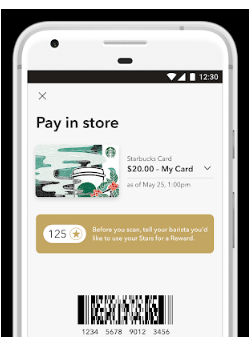 Starbucks leads mobile payments in the US and will likely keep its crown as the country’s most popular proximity mobile payment app. A big reason that Starbucks leads mobile payments is loyalty points, which users receive for each purchase. Starbucks is slightly ahead of Apple Pay, followed by Google Pay, Samsung Pay and others including retail mobile apps, according to a new report from eMarketer.
Starbucks leads mobile payments in the US and will likely keep its crown as the country’s most popular proximity mobile payment app. A big reason that Starbucks leads mobile payments is loyalty points, which users receive for each purchase. Starbucks is slightly ahead of Apple Pay, followed by Google Pay, Samsung Pay and others including retail mobile apps, according to a new report from eMarketer.
Compared to the Google Pay and Samsung Pay apps, Apple Pay had a head start because it launched earlier and is now accepted at more than half of US merchants. Google Pay is not as widely accepted, but it benefits from being preinstalled on Android phones. And Samsung Pay is the most widely accepted, but it hasn’t caught on.
Overall, the number of proximity US mobile payments users will rise 14.5 percent this year to 55 million. In 2018, for the first time, more than 25% of US smartphone users ages 14 and older will make a proximity mobile payment at least once every six months. For more about how Starbucks leads US mobile payments, check out the eMarketer report. — MV
Facebook high speed wireless coming in 2019
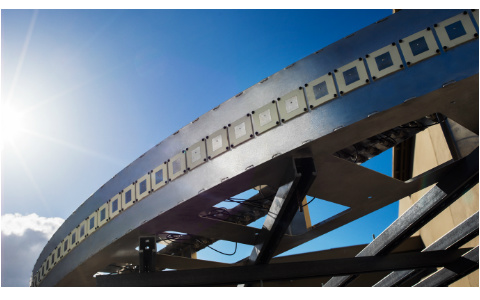 Facebook and Qualcomm are teaming up on a high-speed Facebook wireless service called Terragraph, which is a millimeter-wavelength, 60GHz system that can penetrate even thick concrete buildings. Qualcomm will put Terragraph tech in its upcoming chipsets, so that manufacturers can build 60GHz broadcast equipment. The companies plan to start real-world testing the fast Facebook wireless service in mid-2019, though they didn’t say where.
Facebook and Qualcomm are teaming up on a high-speed Facebook wireless service called Terragraph, which is a millimeter-wavelength, 60GHz system that can penetrate even thick concrete buildings. Qualcomm will put Terragraph tech in its upcoming chipsets, so that manufacturers can build 60GHz broadcast equipment. The companies plan to start real-world testing the fast Facebook wireless service in mid-2019, though they didn’t say where.
Google has also adopted millimeter wireless tech to use in the “last mile” of its Fiber internet service. We don’t know yet if the new Facebook wireless service would be a competitor to Google Fiber, or more like Facebook’s current, no-cost ‘Free Basics’ service with a greatly limited choice of web services. Facebook Free Basics is now available in up to 50 nations via 81 mobile providers. — MV
New Australia tech center opens for AR/VR
Australian federal research agency CSIRO’s data science branch Data61 has opened a large tech lab built to develop augmented reality (AR), virtual reality (VR) and 3D web technologies. The new Australia tech center is called the Immersive Environments Lab (IXL) and is located in Australia’s capital, Canberra. The tech lab has wearable holographic computing devices, virtual touch displays, spatial cameras, interactive mapping systems and motion capture systems. The IXL is also partnering with small and medium business enterprises and government agencies to help them adopt advanced technologies early. — MV
Improving AR app security
As wonderful as AR is and will continue to be, there are some serious privacy and security pitfalls, including dangers to physical safety, that as an industry we need to collectively avoid. There are also ongoing threats from cyber criminals and nation states bent on political chaos and worse — to say nothing of teenagers who can be easily distracted and fail to exercise judgement — all creating virtual landmines that could slow or even derail the success of AR.
Without widespread familiarity with the potential pitfalls, as well as robust self-regulation, AR will not only suffer from systemic security issues, it may be subject to stringent government oversight, slowing innovation, or even threaten existing First Amendment rights. For the whole story on improving AR app security problems, head over to TechCrunch. — MV
—
This mobile news roundup is by MobileVillage Editor Gary Thayer and Erin Bailey of Appcelerator, a top mobile development platform company. Want your news featured in ‘Mobile Week’? Please check out our guidelines. We give preference to mobile news about trends, innovations, major app updates, big players and official Mobile Star Awards Entrants.
Trending mobile news tags this week: Hydrogen One 3D phone with 8K camera, OnePlus 6 reviews, HTC U12+ specs, Belkin audio Lightening cable, cheap Microsoft Surface, SharePoint spaces, SharePoint app find feature, Android phone security, Twitter limits other apps, Starbucks leads mobile payments, Facebook wireless service, App Store improved app discovery, new Australia tech center, improving AR app security
